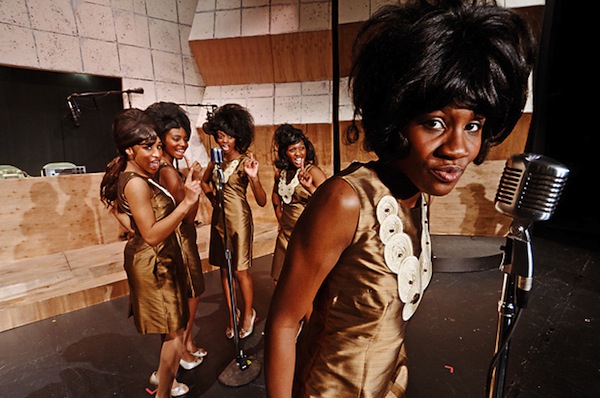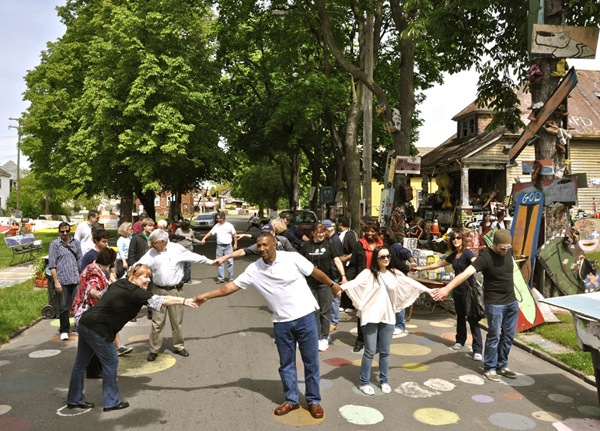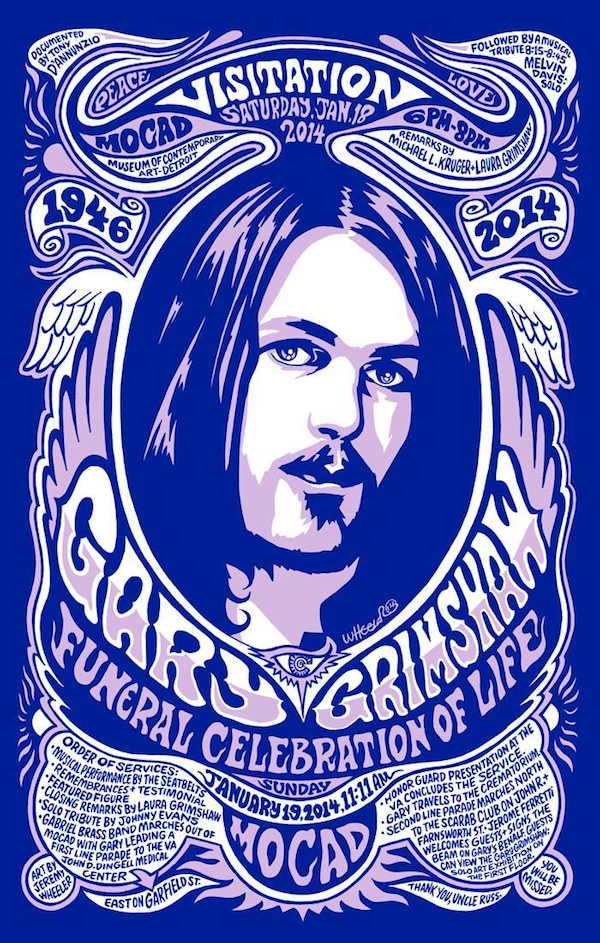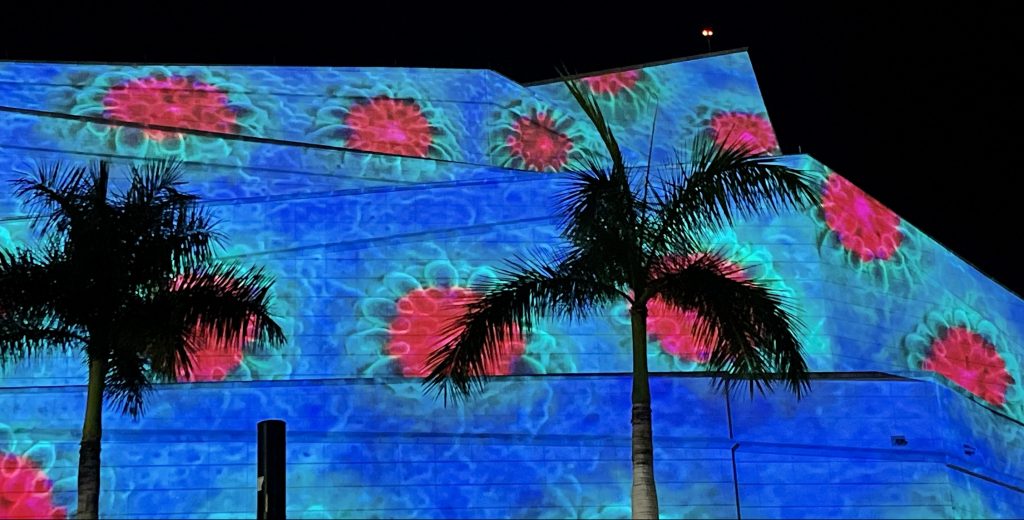
How the arts inspire change in Detroit
The Mosaic Youth Theatre, a first-year winner of the Knight Arts Challenge. Photo by Doug Coombe
By Anna Clark, Creative Exchange This story was originally published in Creative Exchange and was produced in partnership with Springboard for the Arts and the Aspen Institute Arts Program. For more stories of community transformation through the arts, please visit Creative Exchange at SpringboardExchange.org. This story is the first in a three-part series about urban transformation through the arts in Detroit. How do the arts make places more connected, safer, healthier, wealthier, and more vibrant? Writer Anna Clark will explore the vital role that art plays – and has always played – in affecting meaningful community change. In January, three days after an opening reception for an exhibition of his art at Detroit’s Scarab Club, Gary Grimshaw died after a long illness. The legendary graphic artist was famed for his rock music posters, which spotlighted everyone from Jimi Hendrix to Iggy Pop and the MC5 to the White Stripes. With high-voltage color and flowing psychedelic power, his art enticed fans to Detroit’s Grande Ballroom for years, and today are highly prized collectables. Sometimes, he pushed the line. When one of his works (a kite) was challenged as obscene, his 1969 victory in the Michigan Court of Appeals overturned Detroit’s obscenity ordinance, on the grounds that the ordinance inhibited constitutionally protected free speech.
Not a city to let its artists go lightly, Grimshaw’s funeral in Detroit became something extraordinary. The Museum of Contemporary Art Detroit (MOCAD) hosted a Saturday night public visitation, followed, naturally, by live music. The next day, MOCAD hosted a funeral service that culminated in a New Orleans-style jazz band leading a celebratory procession of attendees out the doors of the museum, down Detroit’s streets, and to the grounds of the VA hospital, where formal military honors were done. (Grimshaw was a Vietnam veteran.) The funeral parade then continued north to the Scarab Club for a reception held among Grimshaw’s vibrant art. There, the Scarab Club unveiled Grimshaw’s signature on a beam in its famed artists lounge. For over 100 years, this is where legendary artists, including muralist Diego Rivera, novelist John Dos Passos, and illustrator Norman Rockwell, have ritually made their mark in Detroit.
It is a point of honor to sign a beam at the Scarab Club, and Grimshaw, ill in the hospital as his final show was being arranged, wanted to be part of it. “He wanted so badly to sign the beam, we were trying to get an ambulance to take him over so he could do it,” said Treena Flannery Ericson, Scarab Club’s gallery director. The ambulance didn’t work out. But Grimshaw’s wife and local artist Jerome Feretti worked together to transfer his signature onto it all the same. It was ready to debut by the time of the Sunday reception.
“The beauty of this funeral was the involvement of so many people from the community, people who participated in a full celebration of his life,” said Ericson. “That’s one of the things I love: Everything goes back to the community for any one of these arts groups.”
In Detroit, art isn’t just something to look at. Neither is it something to consume. Rather, it is an active part of civic life, cultivating community resilience by connecting people and places across the city’s 139 square miles. In a city where municipal bankruptcy and deindustrialization has shredded both the public and private sectors, artists and organizations have an unusually large impact—they are literally changing the landscape. Tens of thousands of vacant lots and buildings here mark the daily lived experience of citizens: artistic intervention, whether it is a mural painted on an empty building or an organized program, interrupts the disheartening pattern.
Write A House, a new nonprofit, is renovating vacant homes in Detroit and giving them away, for keeps, to talented writers. The program has attracted international attention as an unprecedented literary arts experiment, offering a lifetime of support to writers. But equally important is WAH’s impact on a residential neighborhood marred by vacancy, says Sarah F. Cox, WAH’s co-founder and vice-president. (In disclosure, I’m on the board of WAH.) The program currently owns three vacant homes in the same neighborhood, one of which is being renovated.
“Filling in three houses that had been vacant for a long time does change things,” Cox said, noting how persistent vacancy destabilizes a neighborhood and creates a dangerous landscape for residents. WAH members are also attending neighborhood safety meetings and working alongside residents, the local police, and their city council representative to “really give back to the community.” While tearing down vacant homes dominates the conversation about blight in Detroit, Cox said WAH offers a small but meaningful alternative model for how the city can address neighborhood vacancy.
When it comes to arts in Detroit, the collective creative impact broadens residents’ sense of what is possible for the city, tells the city’s story to others around the world, and facilitates imaginative re-thinking about what citizens have to contribute the place they call home.
And none of this is new.

The Heidelberg Project during the organization’s “Dancin’ on the Streets (DOTS)” festival in 2010. Photo courtesy the Heidelberg Project.
A historic city of the arts
Detroit’s history underscores the importance of engaging artists directly in the city’s revitalization, not just leaving them on the fringes as so much decoration.
Broadside Press, founded by poet Dudley Randall in Detroit in 1965, was the pioneering publisher of black poets who, at the time, were not getting the literary respect they deserved. As a leading force in the Black Arts Movement, Broadside enriched the national culture by publishing Gwendolyn Books, Sonia Sanchez, Audre Lorde, Etheridge Knight, and Nikki Giovanni.
While Broadside brought a national and world audience to these writers, it always retained its civic engagement in the community that gave rise to it. Randall himself was a Detroit city employee in the 1960s – a librarian at the Parkman branch, which regularly hosted neighborhood poetry workshops. As a young man, Al Ward went to one of the workshops and found his interest in poetry encouraged by Randall. Later, Ward enrolled at the University of Detroit, and he found Randall there too, in a new post in the university’s library. Today, the library features a national Literary Landmark plaque that honors Randall, and it keeps his papers. The university sponsors the Dudley Randall Center for Print Culture.
“Dudley was bringing to the forefront all of these voices dealing with the issue of the struggle of black people in dealing with a tradition of discrimination and inequality and so forth,” said Ward, who eventually became a Broadside-published poet himself. He is currently a board member of the press.
Today, Broadside continues to publish and issue reprints of its work, as well as engage with 21st century Detroiters, often in collaboration with other institutions. It hosts readings, performance theater projects, and young writers programs. It also led an oral history project about Idlewild, Mich., a legendary resort community for African Americans. Every summer, it runs the Institute of Cultural Studies, a series of workshops that is open to the public. Participants of all ages read the poems of Broadside and, as board member and poet Aurora Harris put it, they “relate them to the struggles of the past and today.” It all connects to Broadside’s primary purpose: through literature, the press is cultivating a sense of ownership among citizens for their own story. Harris calls it “being part of a family and community of legacy keepers.” It is the same attitude that makes for engaged citizens.
Catalytic arts projects of the latter-day inspire those that are coming next. The Heidelberg Project is one of most famed examples of this: since 1986, artist and resident Tyree Guyton has developed a community that uses found art in imaginative ways, utterly transforming vacant homes and lots over two blocks on Detroit’s Heidelberg Street. It grew to become Detroit’s third-most popular tourist destination (behind the DIA and Motown Museum—other arts-centered institutions), drawing visitors into the city even at a time when the city’s struggles were publicized around the world.
“The reason the art is there was to protect and preserve that community (on Heidelberg Street),” says Katie Hearn, HP’s marketing and communications manager. “Certainly the reason Tyree started it was that he needed an outlet, but more so, he wanted to give voice to community being entirely ignored by all resources.” (Guyton, incidentally, is another artist whose autograph is on the Scarab Club beam.)
Detroit’s 48207 zip code was one of the most dangerous in the city in the mid-1980s. The Heidelberg Project served as a cry for attention—and it was heard. For 26 years after its founding, Hearn said, no serious crime was committed on HP’s swath of the city, a significant change from the pattern before its existence. (Unfortunately, a recent string of arsons broke that record.) Heidelberg continues to be a touchstone, a place in a segregated city that serves as common ground for diverse people. As Hearn describes it, those who visit and engage with the project are “of all different races, city and suburbs, international people, surrounded by art that speaks to them and allows everyone to share in that dialogue.”
Heidelberg’s emphasis on breathing new life into found objects and space in order to amplify a community is echoed elsewhere in younger projects, including the Lincoln Street Art Park, a sculpture park in New Center. By exploring the meeting point of the natural world, the built environment, and human interaction, the pocket park is meant to grow and evolve alongside the changing community. In a way of taking a model pioneered by HP and making it its own, Lincoln Street Art Park has a strong connection with graffiti artists—who, of course, are among the most visible artists in the city’s landscape.
Building – and funding – a culture of support
To help make it possible for today’s artists to live and work in Detroit, philanthropists have stepped in to offer a hand. Between 2007 and 2011, at the peak of the foreclosure crisis and automaker bankruptcies, foundations gave more than $628 million to the city; $120 million of that was given to the arts, equivalent to what was given to community improvement programs. In comparison, the smallest portion, $30 million, was given to housing and shelter programs. Education programs received $92 million.
Foundation money materializes in a variety of ways. Lincoln Street, for example, is supported by the Michigan Council for Arts and Cultural Affairs and the Detroit Department of Recreation. Knight Arts Challenge is a program that provides matching funds to an array of individual artistic ventures in the city; nonprofit status is not required. But the Kresge Foundation is the heavyweight among foundations investing in the city. It awarded about $165-million in grants here between 2007 and 2011. As well, the Kresge Arts in Detroit program provides individual $25,000 grants to artists, designed for them to use however they see fit.
Of course, philanthropists fund art in cities around the country and world, but the impact of these artistic investments is disproportionately large in Detroit. The vacuum in the public and private sectors means that art-based philanthropic ventures are unusually transformative. In an extreme example, philanthropies, unions, businesses, the city, and the state worked together to craft the “grand bargain” – the plan to reduce pension cuts to retirees and protect the art collection of the DIA as part of the city’s ongoing bankruptcy trial. Knight, Kresge, the Ford Foundation, and seven other philanthropies gave more than $370 million of the $816 million deal—nearly half the total. Comparatively, the state of Michigan gave $195 million to the grand bargain. In addition, several foundations gave directly to the DIA to help the museum reach its own $100 million pledge for the bargain.
Rip Rapson, president of the Kresge Foundation, told the Chronicle of Philanthropy that philanthropic ventures designed to revive a city “has never been attempted at the scale it’s being attempted in Detroit. Without being grandiose about it, there’s nothing even close.”
An arts community changing, and changing with, the city
Why is the arts community so valuable to Detroit?
Detroit’s long-standing institutions have grown up alongside the community, serving as an important nexus for social change and civic health in a region that has been starved for it. It’s a story that is told through a million small tales.
Here’s one: The Scarab Club was once for men only. But in 1962, twelve years after Detroit elected its first female city council member, The Scarab Club began accepting women as full members. That same year, it became (somewhat pointedly) the venue for the founding meeting of the Michigan chapter of the National Organization for Women.
Over the years, The Scarab Club became increasingly interested in the power of art to heal a region scarred by racial and class divisions. This summer is the third year of a program Scarab runs in partnership with Focus: HOPE that brings high school students from Detroit and the suburbs together for a photography mentorship. They work in groups led by an acclaimed local photographer, and they are not allowed to be in a group with anyone they already know. Through art, the students interact with people they otherwise might find easy to avoid. In a Scarab Club exhibition, each student has a framed photograph on the gallery walls, alongside a written statement. Ericson says that one of her favorite parts of the program is watching exhibition visitors pause before the images and read what the young people have to say.
“The thing that’s important is not just the artists who are (members of Scarab Club), or invited to give gallery talks or lectures or openings or whatever, but also just people who appreciate the arts,” Ericson says. “All (Detroit) arts organizations together give people a sense of place and pride in the community. They feel a sense of ownership when they get involved with any of these organizations.”
In a tradition that carries forward to today, many artists in Detroit are uncommonly responsive and accountable to the non-artists in their community.
“That’s hugely encouraging to me, because we’re all in the same boat after our experience of city government not being held accountable,” says Katie Hearn of the Heidelberg Project. “All the artists who are creating and doing their thing are still able to remember the role they play, and the stakes in the larger community.”
In a city like Detroit, where the civic fabric has been stretched the point of tearing apart, that kind of community involvement is essential.
“Somebody can have an idea and just make it happen,” Ericson says of the Detroit arts community. “That’s one of things I think is remarkable about Detroit: Nobody is waiting for someone else. They’re just doing it.”

Poster art for Gary Grimshaw’s visitation by Jeremy Wheeler
Recent Content
-
Artsarticle ·
-
Artsarticle ·
-
Artsarticle ·
